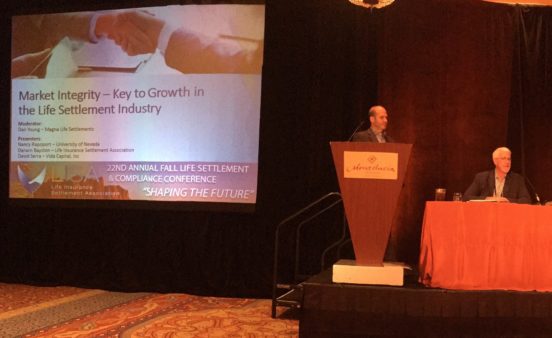Trends In America’s Aging Senior Population

Everyone who works with seniors knows that the American population is older than ever before, but what are the broader implications of this upward aging trend? How can people over 65 and their advocates optimize the retirement years? Dan Veto, a senior advisor for Age Wave, addressed these questions in depth at the Life Insurance Settlement Association (LISA) Life Settlement and Compliance Conference, held in Orlando in October 2018.
Age Wave, considered one of the nation’s leading thought leaders on the aging U.S. population, engages in relevant research and consulting for a variety of industries that seek to enrich the lives of individuals over 65. Veto’s keynote was geared toward helping attendees understand how to best serve seniors in a rapidly changing demographic landscape. Early in his talk, Veto set the stage by pointing out that “two-thirds of the people in the history of the world who have attained the age of 65 are alive today.”
Research from Age Wave shows that 57 percent of seniors regard the retirement years as a new chapter in life, full of opportunity, versus “a winding down of life”(20 percent) or “a continuance of what life was” (23 percent). Other related studies examining the upward aging trend in the U.S. fill out the picture of the needs and opportunities for American seniors today.
Magna Life Settlements Overview
Disparities in Senior Health Care
More seniors surveyed by Age Wave about the factors that disrupted their work and retirement plans indicated that a personal health problem forced them to make different choices, and a gap exists between expectation and reality regarding the eventual need for long-term care. While just 37 percent of seniors believe they will need long-term care at some point, 70 percent actually do need it, and therefore many are ill-equipped for the financial demands.
One repercussion of America’s aging population is the issue of the disparity in available medical care between seniors of means and those in lower income brackets. Research from the National Institute on Aging also traces the differences to ethnicity; studies show that those in lower socioeconomic categories have shorter life spans and more health problems, and the incidence of Alzheimer’s is higher among African-Americans and Hispanics than any other group.
Key Demographic Factors
Survey and census data of older Americans is revealing, but broad trends don’t present a comprehensive picture. Geographical, racial and gender breakdowns examined within the new Profile for Older Americans put out by the Administration for Community Living provides a deeper understanding. Among the findings:
- Women still live longer than men, but the disparity is not as pronounced as it once was. The remaining life expectancy for those who have reached age 65 is 20.6 years for females and 18 years for males. Additionally, men have more money to live on in retirement than women. Median income for males over 65 is $31,618, as compared to just $18,380 for females.
- Seniors in District of Columbia and states such as Mississippi, Louisiana, New Mexico, and New York are more likely to live in poverty than those who live in Arizona, Connecticut, Delaware, and New Hampshire. In 2016, the five states with the highest percentage of residents over the age of 65 were Florida (19.9%), Maine (19.4%), West Virginia (18.8%), Vermont (18.1%), and Montana (17.7%).
- As the American population at large becomes more diverse, so does the over-65 demographic. In 2016, ethnic minorities made up 23 percent of the American senior population, but according to projections the percentage of Hispanic seniors will more than double by 2050 and the percentage of older Asians will see a similarly dramatic increase.
Seniors And Work
The number of Americans over 65 in the workforce has steadily increased in the past three-plus decades, undoubtedly because of the rising costs of retirement. From a low point of 15.8 percent in 1985, the percentage of senior men working today is upwards of 20 percent, and in the same time period women over 65 in the workforce increased from 7.3 percent to 15.7 percent. The total of seniors who either need or want to continue working will continue to mushroom as the population ages.
The decision to return to work isn’t always purely financial. According to RAND’s American Working Conditions survey, more than half of the retirees who participated indicated that they would go back to work if the right opportunity presented itself, and the desire to find meaningful work is often even more important than the need for steady income. “Significant numbers of older people move in and out of the workforce,” said Kathleen Mullen, one of the authors of the RAND report. “Retirement isn’t necessarily permanent.”
Where Life Settlements Fit Into The Equation
Amid the various dynamics of America’s aging trend, the need for new income sources for those in their later years is more pressing than ever. The convergence of rising health care costs, the age wave in America, and the growing gap between the average retirement age and average life span has raised the profile of life settlements as a valuable option for seniors looking to meet unexpected needs and write the best possible last chapter for their lives.
In his remarks, Veto addressed the ripeness of the opportunity for settlement providers to step in and provide answers for older Americans. “These social and economic trends create rising opportunities for life settlements as an option for some seniors who may benefit from an ‘equity release’ of a life insurance policy,” he said. “This may be an option for them to generate income to help fund their retirements.”









